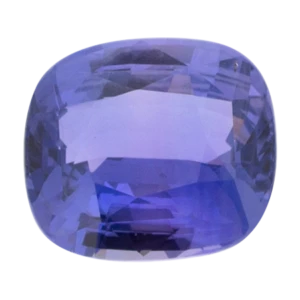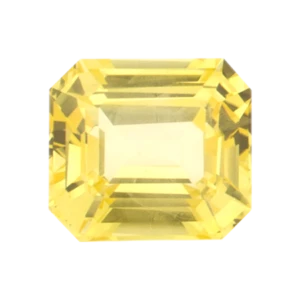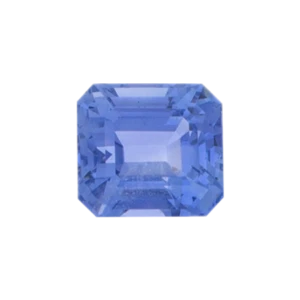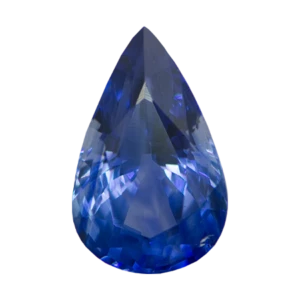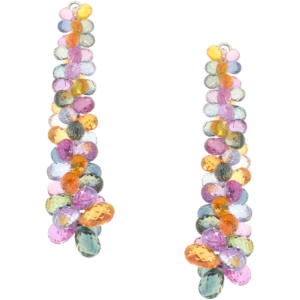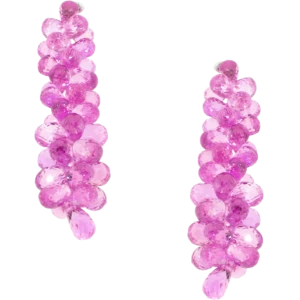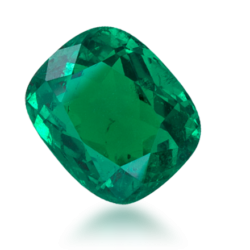Sapphire
Sometimes called «popes’ stone», sapphire is a precious stone generally of a deep blue that has multiple virtues. Mounted in necklaces, rings, earrings or pendants since antiquity, it ensures its wearer serenity, strength and courage. What do you need to know about sapphire in order to imagine a unique and tailor-made jewel? We reveal the secrets of this exceptional gem.
Sapphire: its main characteristics
Etymologically, the word sapphire comes from the Greek, sappheiros (which was then repeated in Latin by the term sapphirus) and which means blue. However, the sapphire family can reveal several shades.
Generally, in the blue colors, some stones can have shades of pink, purplish, yellow, orange or green, although this is very rare. There is a colorless sapphire called leucosaphir, which visually resembles a white diamond.
Sapphire, a very resistant stone
Mineralogically, sapphire belongs to the group of corundum (the same applies to rubies) which includes mineral species mainly composed of aluminium oxide. Also known as alumina, it is a metal oxide naturally present in the Earth’s crust. In the case of sapphire, the elements of titanium and iron give the stone its bluish hues. As for its color variations, they come from the «impurities», the oxides present in the composition of the mineral, making each stone extracted from the soil absolutely unique.
The hardness of the sapphire, at 9 on the Mohs scale, again brings it closer to the diamond (categorised at 10). The mineral composition of the corundum was chemically reproduced in 1973 using zirconium oxide to create a diamond-like mineral. It is thus possible to obtain chemically a stone close to the sapphire.
Sapphire and associated symbols
Sapphire has been known since antiquity because of its exceptional appearance and the virtues that have always been lent to it. The ancient Egyptians, and later the Romans, wore it as an everyday jewel because of its very high resistance. Ancient Rome has also made sapphire the stone of truth and justice. In Persian culture, it was most often worn in the ears and was thought to reflect the blue color of the sky. Later in the West, sapphire became the symbol of purity: the cardinals of the Catholic Church wore it in a ring in their right hand.
Its blue color has long been associated with royalty. In Europe, the purest sapphires are mounted in earrings, tiaras or tiaras, silver and gold perfectly paired with the color variations of the sapphire. The famous Saphir Louis XIV is the first precious stone of this type that will join the jewels of the Crown of France.
A symbol of fidelity and perseverance, it is called the sapphire wedding anniversary, the date on which a jewel set with a sapphire is still offered today.
How much does a sapphire cost?
Sapphire is considered to be the purest stone of the three colored gemstones, along with ruby and emerald. If its quality is variable according to various characteristics and environmental factors, it is possible to recognize a real sapphire based on the quality of the passage of light through the stone.
If there is no obstacle to light, it is a quality natural stone. The most beautiful ones are those that do not have crystal inlay visible to the naked eye. This characteristic influences the price of the sapphire, as well as its weight, the intensity of its color or its origin as we will develop below.
Where can one find sapphires?
There are sapphire deposits in the United States (in Montana, more precisely) in Sri Lanka, India, China, Kenya, Australia, Thailand (the region of Chanthaburi offers gems with blue-green notes) or in Vietnam. The deposit in France of Puy-en-Velay, in Auvergne, which has long provided the highest courts in Europe and the largest jewelers in Paris, is now exhausted.
The most sought-after sapphires come from deposits in Myanmar, Kashmir or Ceylon. Cashmere mines have been extracted from the most beautiful sapphires in the world. But, tapped out in 1979, they are now officially closed. The crystals from these deposits are recognizable by their deep blue color with violet hues.
Myanmar sapphires are also among the rarest in the world and can cost up to several thousand euros per carat. Ceylon, Sri Lanka, is also a highly prized sapphire deposit, where sapphires are becoming increasingly scarce due to the depletion of other mines. The deposits in Ceylon, in the province of Ratnapura, offer stones in blue to blue-lilac tones. Sometimes these mines offer orange minerals with a hint of pink, very rare, they are called padparadscha sapphires (lotus flower, in cingalais).
A stone with a complex extraction
Extracting minerals from the sapphire family is a complex operation that requires working with traditional methods in order not to damage the stones. Training, polishing and mounting a jewelry stone are also high-flying technical steps, which only the best jewelers are able to perform successfully. Rare, but nevertheless attractive and aesthetic, these are the reasons why the price of sapphire is high, although it varies according to the quality of the stone.
The price of the sapphire depends on its weight (which is expressed in carats) and 1 carat corresponds to 0.20 gram. Thus, for a sapphire of very average quality of 3 carats, the price is around 2000 euros. On the other hand, for a AAA sapphire stone (which is the best quality rating on the market), the price of 3 carats is more than 10,000 euros.
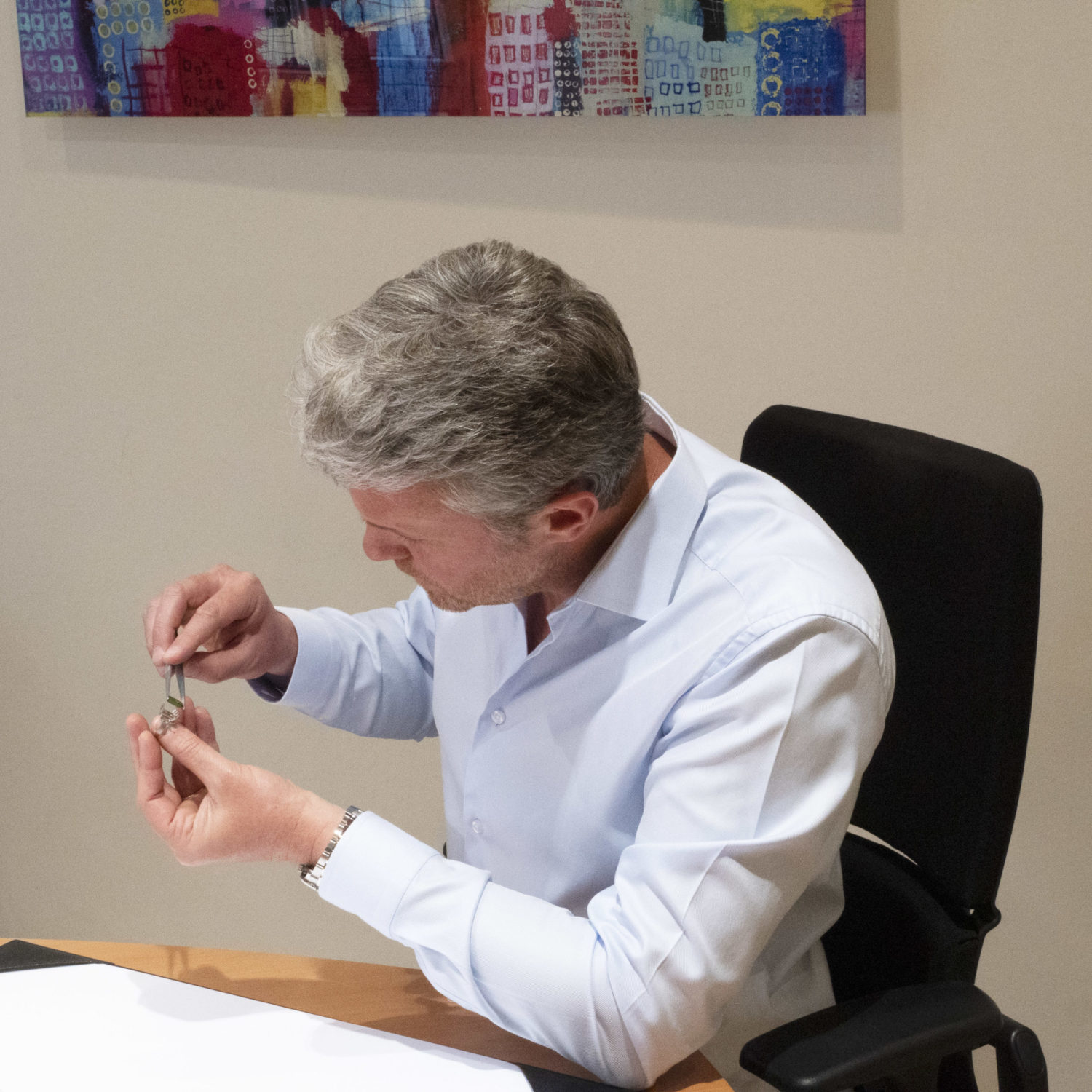
Which virtues has sapphire?
In lithotherapy, Sapphire is widely used as a preventive stone. It allows to detect the weak points of the body upstream and to avoid diseases.
Sapphire and psyche: virtues of sapphire on morale
The virtues associated with sapphire are multiple. Blue sapphire has, throughout history and in many cultures, been linked to faith, fidelity, stability and appeasement. Anchor stone, it promotes balance and is particularly suitable for people born under the astrological sign of Gemini. Helping to develop tenacity and patience, it is often recommended to people in a hurry and fickle looking for balance and a lull in the energies and flows around them. Sapphire promotes inspiration, spiritual elevation and helps with meditation by calming mental activity.
Soothing, this gem reduces anger and alleviates fears, unleashing the potential and dynamism of its wearer. Reducing sadness, it gives way to joie de vivre, stimulates creativity and acts positively on the imagination. In Eastern cultures, it is linked to emotional and irrational intelligence. It is the stone that applies to the top chakra and the third eye. It therefore develops extra-sensory faculties and imagination: it is advisable to meditate with a sapphire to multiply its creative prowess.
Physically weak people, who need to overcome great fatigue, also draw a very great amount of energy from it. Indeed, sapphire is supposed to bring resistance and power to its wearer.
Sapphire: positive effects on one’s body
Due to its calming virtues, sapphire gives way to positive energies in its wearer and consequently helps to develop self-confidence, courage and perseverance. Its psychic benefits have positive consequences on the body, relieving headaches, soothing joint pain and relaxing nerves. It decreases body temperature and therefore tissue irritation, which strengthens the venous system as a whole.
Often used to regenerate skin and nails, sapphire is excellent for relieving sinusitis, bronchitis, and even conjunctivitis. Sapphire is also a mineral known to be beneficial in case of insomnia: by treating hyperactivity, this stone promotes a peaceful sleep and evacuates depressive states of mind.
Is sapphire dangerous?
There is no contraindication in lithography to wear a sapphire; it is quite the opposite. Tradition explains that in case of a break-up, the jewel encrusted with a sapphire must be returned to the one who offered it in order to get truly separated from the energies and affection.
How to clean a sapphire?
Set in jewelry, sapphire does not have great maintenance needs because of its extreme resistance. Warm water and a soft cloth allow it to regain its color and shine. Be aware that to preserve the hues of a gemstone, it is advisable to avoid too long exposure to light. So, when you’re not wearing your sapphire, keep it in a closed jewelry box in a room at room or cool temperature.
In order to purify and recharge a sapphire stone, it is necessary to adopt the cleaning method applicable to all minerals of the corundum family. Sapphire is therefore purified with salt, distilled or demineralized water. The stone must be recharged in the sun, under the rays of the moon or placed on a small pile of quartz.
What jewels to make a sapphire sublime?
Stone of appeasement, it is advisable to wear the sapphire all against oneself to benefit from all its supposed virtues. Thanks to its timeless elegance, sapphire supports all eccentricities. It is perfect set in rings, necklaces or earrings and is sublimated by many shapes. Baguette, round, heart, oval, cushion or pear, the possibilities are immense when it comes to sublimating a sapphire. These faceted sizes emphasize the brilliance of sapphire, making it particularly bright, regardless of the dimensions chosen.
If you prefer round creations, you can opt for a polished and curved cabochon. The cabochon cut is also recommended to sublimate the star sapphires and highlight these natural stones. These particular sapphires are endowed with an asterism, that is to say a star effect due to the play of lights on the inclusions contained in the stone. One of the most famous starry sapphires is the Star of Bombay, a sapphire native to Sri Lanka whose weight reaches 182 carats. This exceptional jewel is distinguished by its blue hue that draws on purple and is now exhibited at the Smithsonian institution. Characterized by its milky blue color, the Star of India sapphire is distinguished by the fact that its two sides are starry. Preserved at the American Museum of Natural History in New York, it weighs 563.35 carats. It is therefore one of the largest sapphires in the world, with the Black Star of Queensland, which culminates in 733 carats.
Thanks to its brilliance and color in shades of blue, the sapphire is sufficient for itself when it comes to wearing it as a jewel. But sapphire can also be combined with other gemstones. Associating the diamond with the sapphire is an ideal choice for an engagement ring for example. It is also possible to bet on audacity by marrying the sapphire with a colored stone or another pink, green, yellow, orange, black or white rather than blue sapphire.
Contact us to get a quote and discover how to create a unique and personalized sapphire jewel. Our creations are accompanied by a certificate of authenticity.
